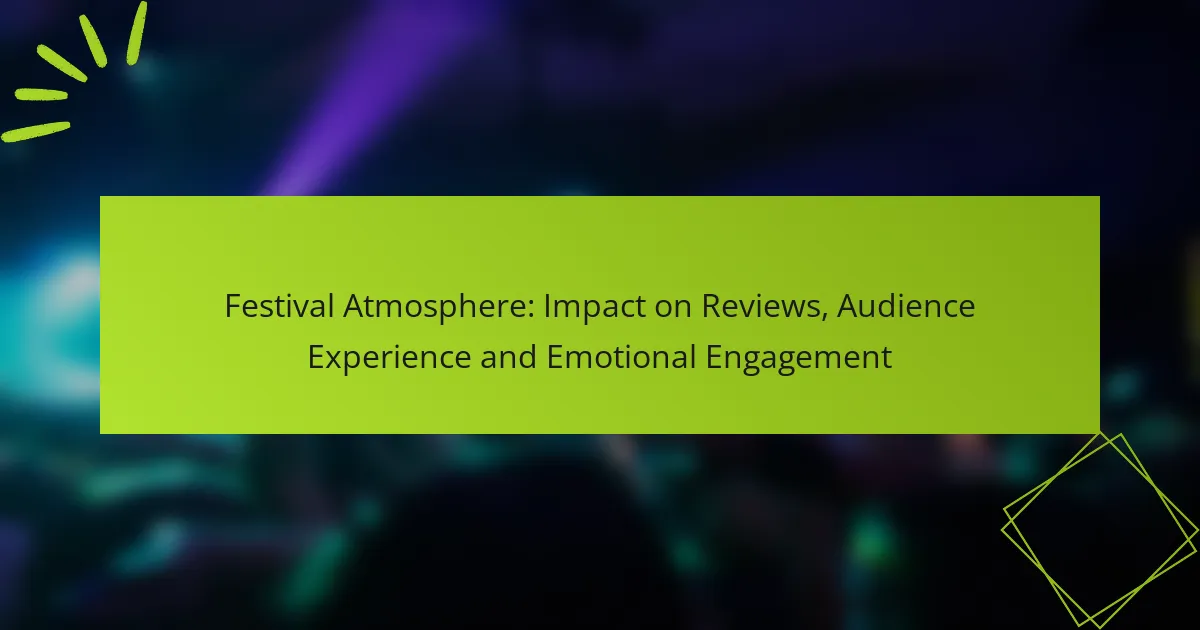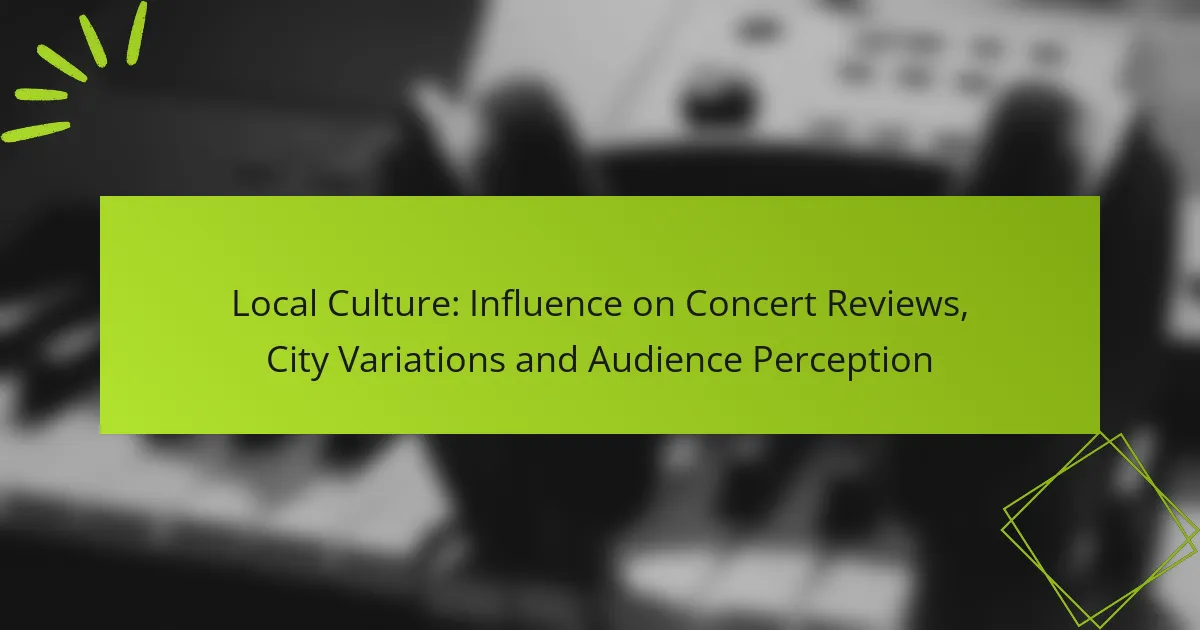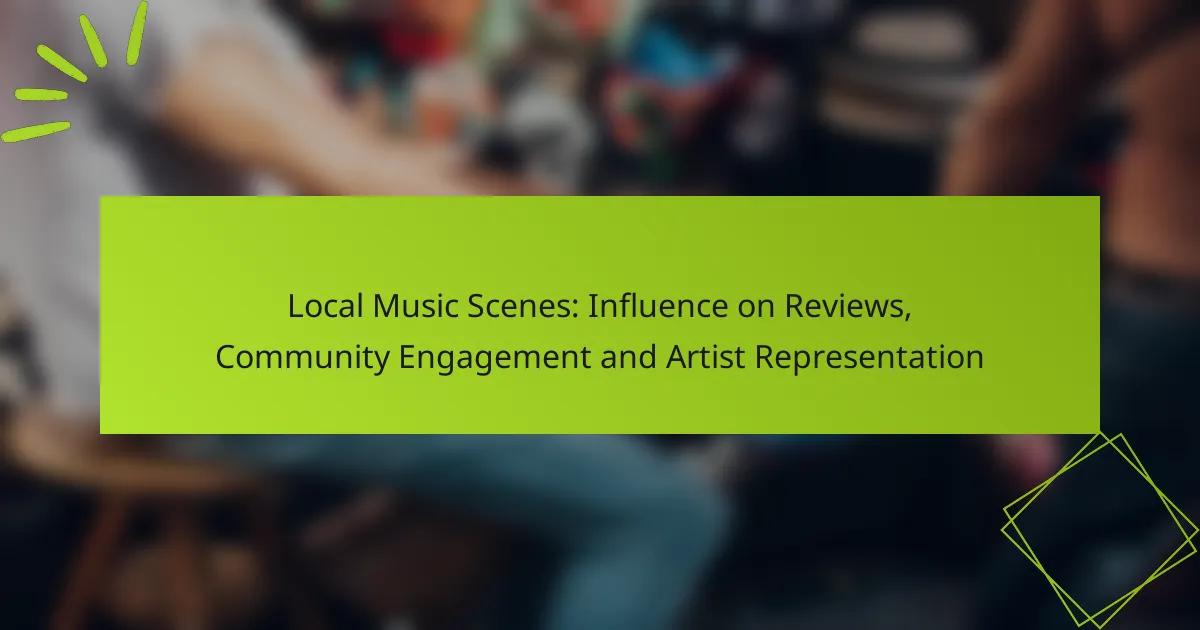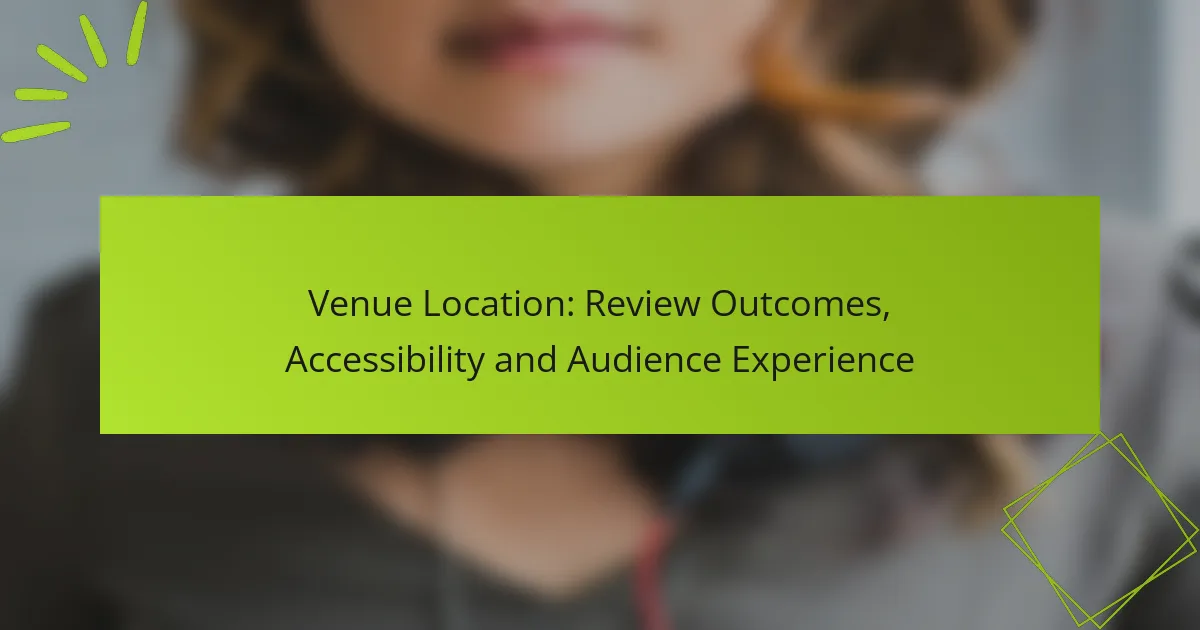The atmosphere of a festival plays a crucial role in shaping audience reviews and emotional engagement. A lively and immersive environment not only enhances the overall experience but also influences how attendees perceive the value of the event. By focusing on elements such as music, venue design, and interactive experiences, organizers can create memorable moments that resonate deeply with festival-goers.
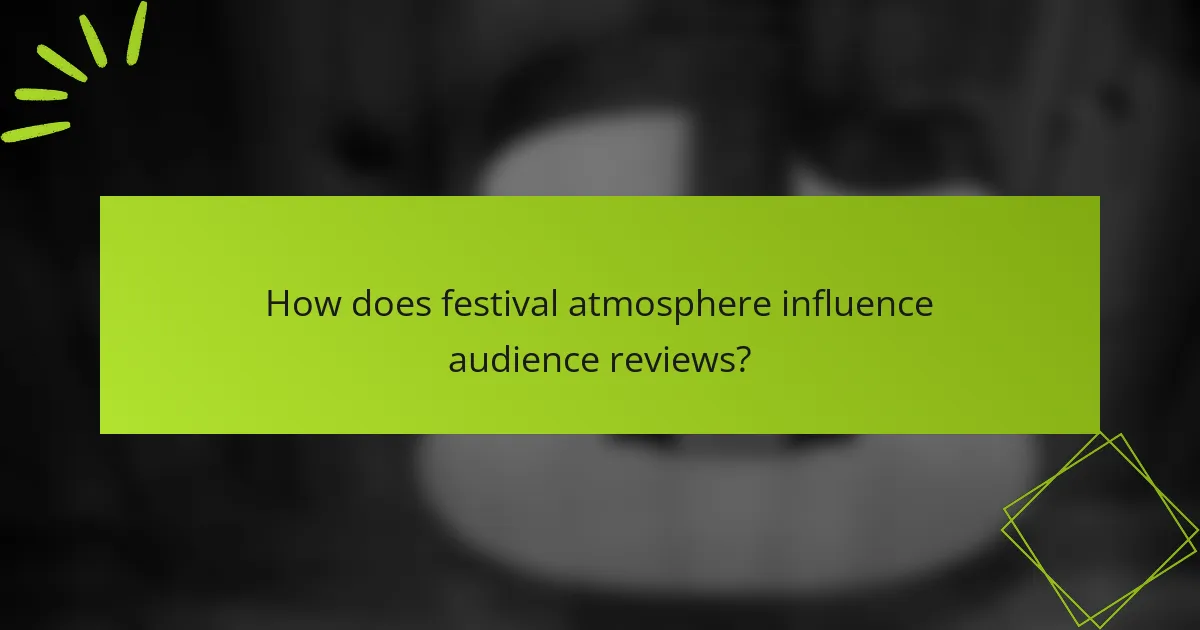
How does festival atmosphere influence audience reviews?
The atmosphere of a festival significantly impacts audience reviews by shaping their emotional experiences and perceptions of value. A vibrant, engaging environment can lead to more favorable ratings, while a lackluster atmosphere may result in negative feedback.
Positive emotional responses enhance ratings
When festival-goers experience positive emotions, such as joy or excitement, they are more likely to leave high ratings in their reviews. These emotional responses are often triggered by elements like music, decorations, and crowd energy, which create memorable moments.
For example, a festival with lively performances and interactive installations can evoke happiness, leading attendees to rate their experience higher. Conversely, a dull atmosphere may leave attendees feeling indifferent, resulting in lower ratings.
Atmosphere shapes perceived value of experiences
The perceived value of a festival experience is closely tied to its atmosphere. A well-designed environment can enhance the overall enjoyment and make attendees feel that their money was well spent. Elements such as themed decorations, engaging activities, and comfortable amenities contribute to this perception.
For instance, a festival that offers unique food options and immersive experiences can create a sense of value that justifies ticket prices. In contrast, a poorly organized event with minimal attractions may lead to feelings of disappointment and lower perceived value.
Social interactions amplify review frequency
Social interactions at festivals can significantly increase the likelihood of attendees leaving reviews. Engaging with friends and fellow festival-goers creates shared experiences that attendees are eager to discuss online. The more social connections made, the more likely individuals are to share their thoughts on the event.
For example, festivals that encourage group activities or have communal spaces often see higher review rates. Attendees who bond over shared experiences are motivated to express their enjoyment, leading to more frequent and positive reviews.
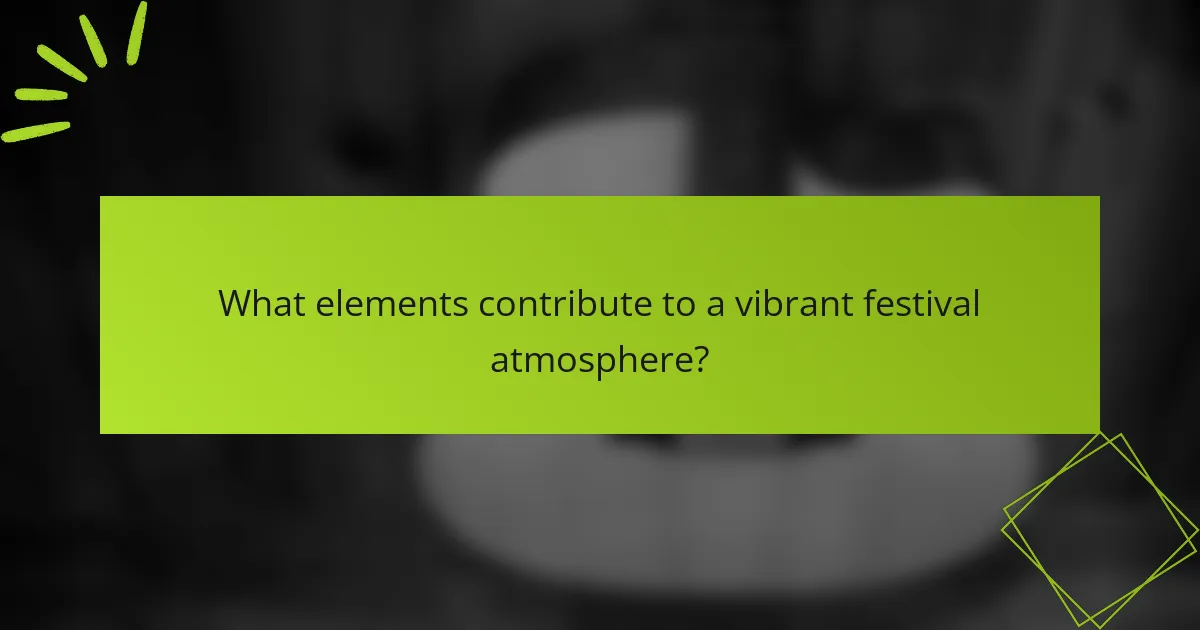
What elements contribute to a vibrant festival atmosphere?
A vibrant festival atmosphere is shaped by various elements that enhance the overall experience for attendees. Key factors include engaging music, thoughtfully designed venues, and appealing food and beverage options, all of which work together to create an enjoyable and memorable event.
Music selection and quality
The choice of music plays a crucial role in establishing the festival’s mood. High-quality performances by popular artists can elevate excitement, while diverse genres cater to different audience preferences. It’s essential to balance well-known acts with emerging talent to keep the lineup fresh and engaging.
Consider scheduling performances at different times to maintain energy levels throughout the event. For instance, upbeat music during peak hours can encourage dancing, while softer tunes can provide a relaxing atmosphere during quieter moments.
Venue design and layout
A well-designed venue enhances the festival atmosphere by facilitating movement and interaction among attendees. Key aspects include clear pathways, strategically placed stages, and comfortable seating areas. An open layout encourages socializing, while designated zones for activities can keep the crowd engaged.
Incorporating elements like art installations or themed decorations can create visual interest and enhance the overall experience. Ensure that facilities such as restrooms and first aid stations are easily accessible to maintain attendee comfort.
Food and beverage offerings
Food and beverage options significantly impact the festival atmosphere, as they provide not only sustenance but also an opportunity for cultural expression. Offering a variety of cuisines can cater to diverse tastes and dietary restrictions, enhancing the overall experience for attendees.
Consider including local vendors to support the community and provide authentic flavors. Additionally, ensure that food and drink prices are reasonable to encourage attendees to indulge without breaking the bank. A well-curated selection can elevate the festival’s reputation and keep attendees coming back for more.
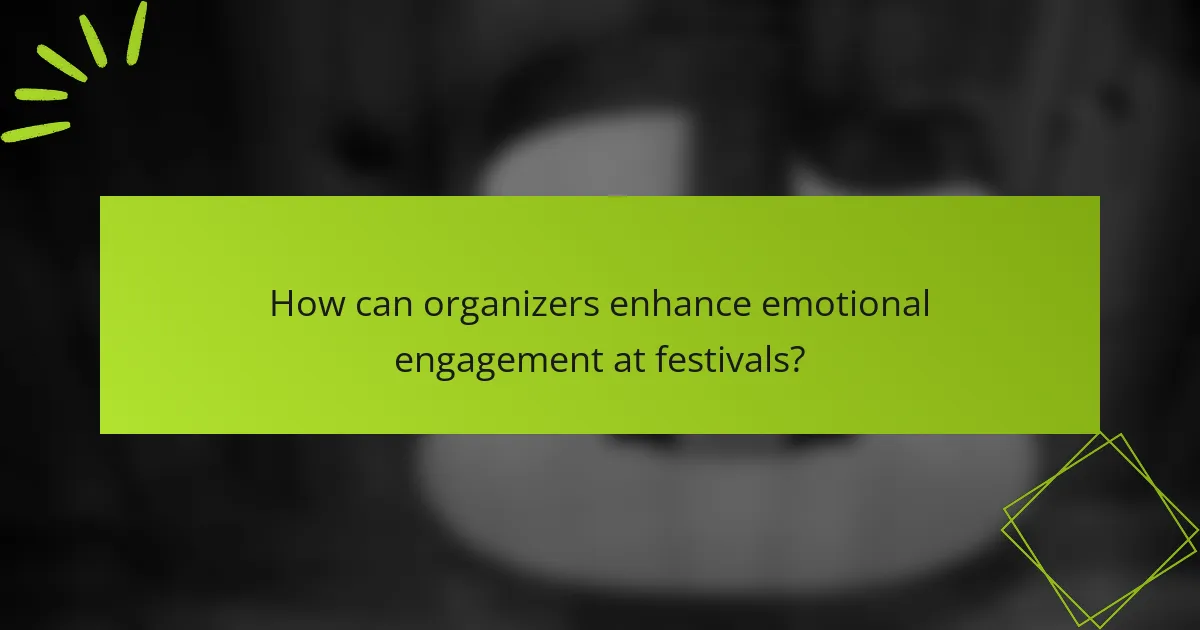
How can organizers enhance emotional engagement at festivals?
Organizers can enhance emotional engagement at festivals by creating immersive experiences that resonate with attendees. This involves incorporating interactive elements, fostering community involvement, and leveraging technology to personalize the festival experience.
Interactive installations and activities
Interactive installations and activities encourage attendees to participate actively rather than passively observe. These can include art installations that invite touch, workshops that allow for hands-on creativity, or games that promote social interaction. Such engagements can significantly boost emotional connections, making the festival memorable.
For example, setting up a collaborative mural where attendees can contribute their artwork fosters a sense of community and shared purpose. Organizers should ensure that these activities are accessible and inclusive to cater to diverse audiences.
Community-driven programming
Community-driven programming involves incorporating local artists, performers, and cultural elements into the festival lineup. This approach not only supports local talent but also creates a sense of belonging among attendees. When festival-goers see familiar faces and cultural references, their emotional engagement deepens.
Organizers can host open calls for local talent, ensuring that the programming reflects the community’s identity. This could include local food vendors, musicians, and cultural workshops that highlight regional traditions, enriching the overall festival atmosphere.
Personalized experiences through technology
Utilizing technology to create personalized experiences can significantly enhance emotional engagement at festivals. Apps that allow attendees to customize their schedules, receive tailored recommendations, or connect with others based on shared interests can make the experience more meaningful.
For instance, a festival app could offer features like personalized itineraries, real-time updates on favorite acts, or even social networking options to meet fellow attendees. Organizers should prioritize user-friendly interfaces and ensure that technology enhances rather than complicates the festival experience.

What role does social media play in shaping festival experiences?
Social media significantly shapes festival experiences by enabling attendees to share their moments in real-time, influencing perceptions and engagement. Platforms like Instagram and Twitter allow users to document and broadcast their experiences, creating a dynamic atmosphere that can enhance or detract from the overall event.
Real-time sharing of experiences
Real-time sharing on social media platforms allows festival-goers to instantly post updates, photos, and videos. This immediacy creates a sense of community among attendees, as they can engage with each other’s content and feel connected to the event, even if they are not physically together.
For example, a festival attendee might post a live video of a performance, prompting friends and followers to join in the excitement or consider attending future events. This kind of sharing can amplify the festival’s atmosphere and encourage more people to participate.
Influencer partnerships boost visibility
Influencer partnerships can significantly boost a festival’s visibility and appeal. By collaborating with popular social media figures, festivals can reach broader audiences and attract attendees who might not have otherwise considered attending.
Influencers often share curated content that highlights the festival’s unique aspects, such as performances, food, and activities. This content not only showcases the event but also lends credibility, as followers trust the recommendations of influencers they admire.
User-generated content influences perceptions
User-generated content plays a crucial role in shaping perceptions of festivals. Attendees’ posts can create a narrative around the event, influencing how potential visitors view it. Positive experiences shared online can enhance a festival’s reputation, while negative feedback can deter future attendance.
Festivals can encourage user-generated content by creating specific hashtags or contests, prompting attendees to share their experiences. This strategy not only increases engagement but also provides authentic insights into the festival atmosphere, helping to attract a diverse audience.
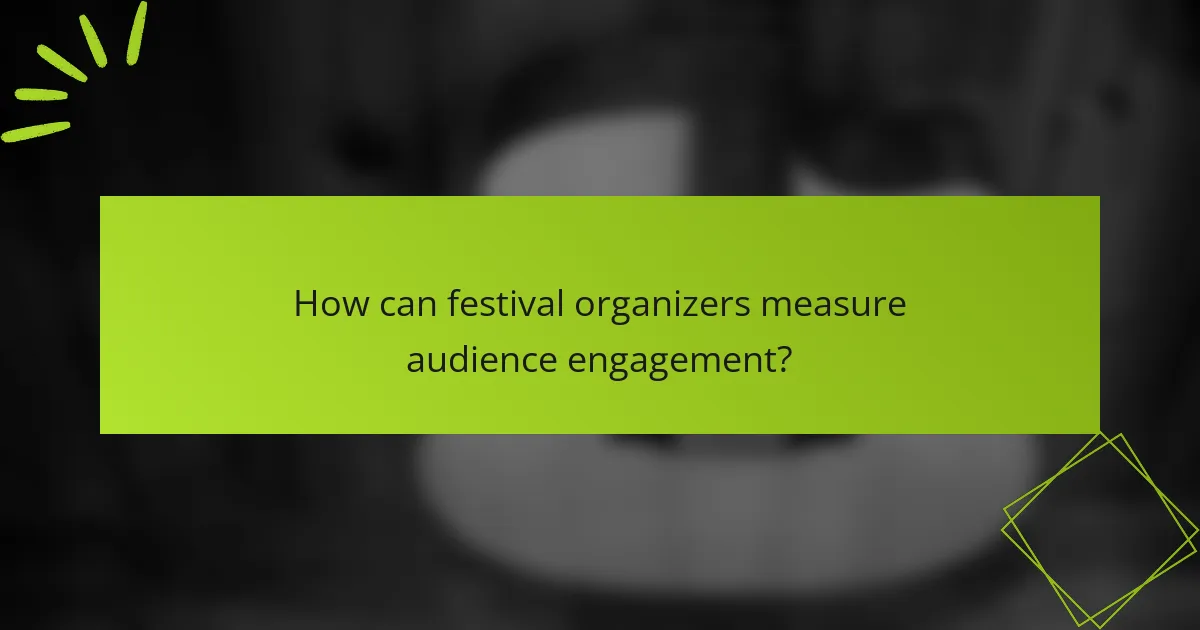
How can festival organizers measure audience engagement?
Festival organizers can measure audience engagement through various methods that capture feedback and participation levels. By utilizing surveys, social media analytics, and attendance metrics, organizers can gain valuable insights into the audience’s experience and emotional connection to the event.
Surveys and feedback forms
Surveys and feedback forms are direct tools for gathering audience opinions and experiences. Organizers can distribute these forms both online and on-site, asking specific questions about attendees’ enjoyment, suggestions for improvement, and overall satisfaction. A well-structured survey can yield response rates of around 10-30%, depending on the incentives offered.
To maximize effectiveness, keep surveys concise and focused, ideally taking no more than 5-10 minutes to complete. Consider using a mix of rating scales and open-ended questions to capture both quantitative and qualitative data.
Social media analytics
Social media analytics provide insights into audience engagement by tracking interactions on platforms like Facebook, Instagram, and Twitter. Organizers can monitor likes, shares, comments, and hashtags related to the festival to gauge public sentiment and engagement levels. Tools like Google Analytics and social media insights can help quantify this data.
Engagement metrics such as reach and impressions can indicate how well the festival resonates with the audience. Aim for a balanced approach by analyzing both positive and negative feedback to understand the full spectrum of audience sentiment.
Attendance and participation metrics
Attendance and participation metrics are essential for understanding how many people engaged with the festival. Tracking ticket sales, entry counts, and participation in activities can provide a clear picture of audience engagement. For example, a festival with a 70% attendance rate compared to previous years may indicate a successful event.
Additionally, consider measuring participation in specific activities or workshops to identify what draws the most interest. This data can inform future programming decisions and marketing strategies, ensuring that the festival continues to meet audience expectations.
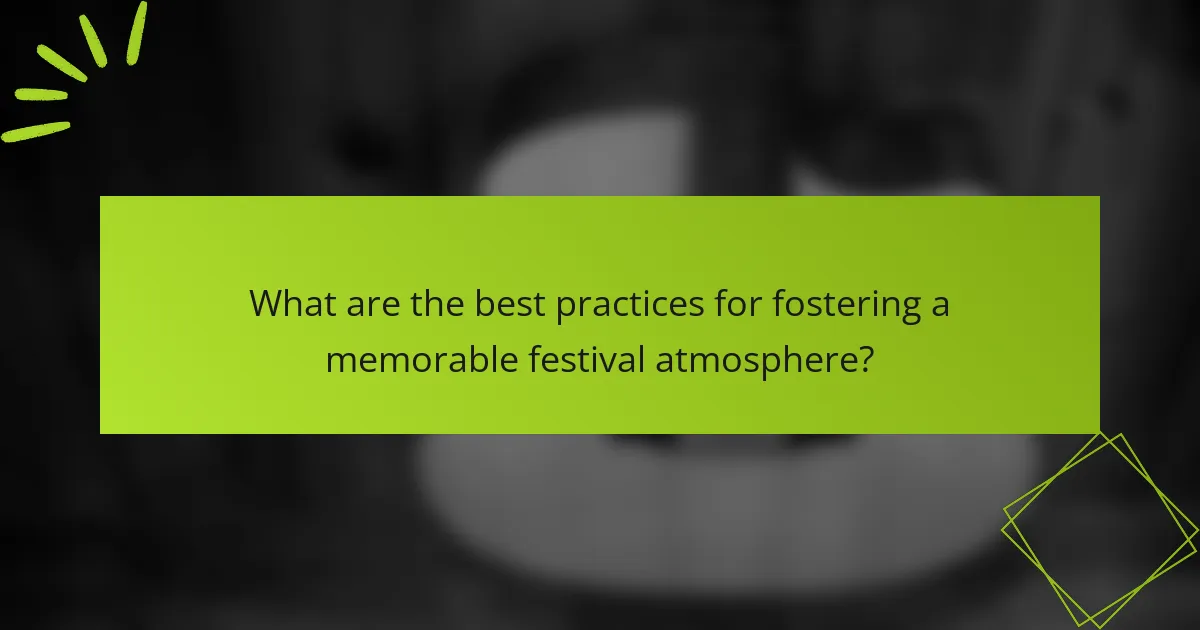
What are the best practices for fostering a memorable festival atmosphere?
To create a memorable festival atmosphere, organizers should focus on engaging the audience through immersive experiences, local culture, and interactive elements. These practices enhance emotional connections and encourage positive reviews from attendees.
Creating immersive environments
Immersive environments transport festival-goers into a unique world that captivates their senses. This can be achieved through thoughtful design elements such as themed stages, vibrant decorations, and interactive installations that invite participation.
Consider incorporating sensory experiences like soundscapes, lighting effects, and even scents that align with the festival’s theme. For example, a music festival might use specific lighting to enhance performances, while a food festival could feature aromas that complement the culinary offerings.
Incorporating local culture and art
Integrating local culture and art into a festival not only enriches the experience but also fosters a sense of community. This can include showcasing local artists, musicians, and craftspeople, allowing attendees to connect with the region’s heritage.
Organizers should consider hosting workshops or demonstrations that highlight traditional crafts or culinary techniques. Additionally, featuring local cuisine in food stalls can create a more authentic atmosphere, encouraging attendees to explore and appreciate the local culture.
